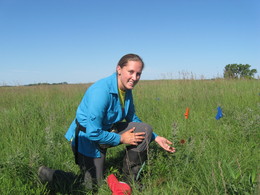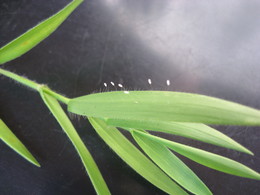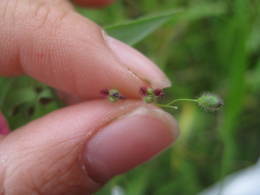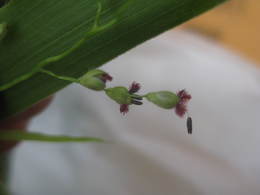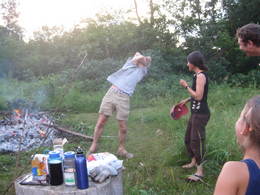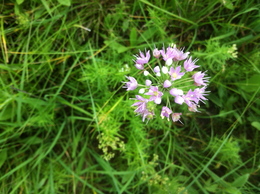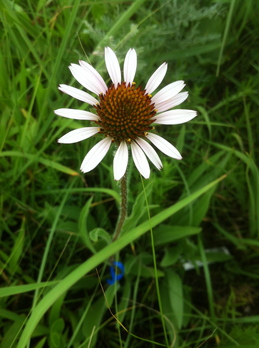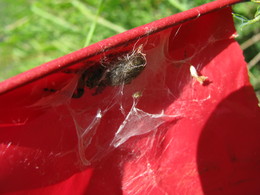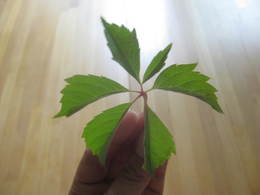|
|
Hallo once again from K-town! It was yet another wonderfully nice day out in the prairie of Minnesota. This morning, Maria and Katherine headed out to the Landfill site to GPS all of the flowering plants we found earlier (about 80 of them this year). Kelly, Jill, and I headed over to Around Landfill to do demography on the plants Kelly used for her phenology project. And Shona and Andrew won (at long last) a battle with our second GPS unit (which arrived yesterday), Chekov. Chekov has come to join Sulu in our endeavors to gain coordinates. But it’s best if both work properly. Oh, and Kelly’s last plant at all her remnants finished flowering today! It’s bittersweet.


We came back to the Hjelm House later in the morning and had time to work on getting things ready and wrapped up for our poster presentations on Thursday. Yoiks! It’s coming up quick! Ruth came up with Lisa, and undergrad, and Dave, a potential post-doc for the Echinacea Project. After lunch, Dave gave us his presentation on his work with Solidago velutina (goldenrod). We then headed over to Aanenson to do demography. There were not very many flowering plants there this year, though Jill and I found a monster of one on the side of the road. We had both GPS units out with us, but we had a ton of trouble with them and were only able to GPS a few plants. We’ll just blame it on solar flares again. Once finished, we reconvened at the Hjelm House for some nummy watermelon fresh from the garden! Maria also found something interesting while we were out. We’re thinking these might be egg sacs of some sort, but we’re not quite sure.

Title: Examining Pollen Limitation in a native prairie panic grass, Dichanthelium leibergii
MW-UMN-30×40.pdf
It has lots of cool pictures and Dichanthelium as the background! 🙂
See you at the symposium!
Here’s the poster I will be presenting at the University of Minnesota on Thursday.
Shona Sanford-Long_compatibility poster_small.pdf
So, a while back when GPS-ing the recruitment plots, there were a number of places where no nail was found in our initial survey. Here’s the list of those point numbers in the GPS:
250
257
276
278
302
319
395
406
These were supposed to have nails, but we were unable to find them.
407
422
428
434
435
Here’s an improved version of my poster on my pilot study of Dichanthelium germination, which I presented at the Undergraduate Research & Arts Expo at Northwestern. It’s pretty much the same content, but less text and neater.
MWangURGExpo2012poster_44_x_36.ppt
Howdy folks,
Maria reporting from K-town.
Sunday we had a real day off =)
The weather was good and sunny, but not too hot.
Random tidbits from the town hall:
Shona made oatmeal pancakes for breakfast – they were really yummy – thanks Shona!
Kelly and Shona went swimming at Elk Lake and bumped into the Wagenius family
Katherine found a new trail in the forest at the Runestone Park on her biking adventure
Andrew had a great time at home and arrived at the town hall before 11pm
Lydia spent the day helping out in the kitchen at the camp in Alexandria
I made Irish Soda Bread to use up some sour milk, but still have ~1 cup sour milk (turned into buttermilk substitute, any ideas what to do with it? Pancakes would be easiest, but we just had them)
After the weekend break, it’s time for work again! Monday (today) we divided and conquered.
AM – Greg set out his yellow pan traps in his remnants. Stuart, Katherine, Jill, Lydia and I did demo in the remnants. Ruth and Greg came to join us. We found many Echinacea flowering at Loeffler’s Corner East, an okay number at Loeffler’s Corner West, 2 at Railroad Crossing (Douglas County), and ~6 at Yellow Orchid Hill.
The others (Shona, Kelly, Andrew) did CG1 rechecks and then worked on their independent projects.
Ruth bought some delicious fluffy spongy chocolate cake which we cleaned off the dish.
PM – The two teams switched jobs. Stuart led Shona, Kelly, Andrew, Ruth and Greg in demo at KJs and On 27. The rest of us did CG1 rechecks, and then worked on independent projects.
Here’s a file called “Crash Course in R”, which might be helpful to folks
crashR.2.pdf
Now for some photos!
Flowering Dichanthelium!

I think this is a super cool picture as it shows 3 stages of Dichanthelium stigmas/anthers emergence. See how the bottom-most spikelet has the stigma just emerging, while the anthers are still inside; the middle spikelet is open and has both stigma and anthers well-exserted; and the top spikelet is closed and the anthers are drooping out from the spikelet.

Last but not least here’s an epic picture from our bonfire last year 😀

Now that the vast majority of Echinacea are finished flowering (except for the populations at Staffanson and one lonely plant at Northwest of Landfill), I’ve started piecing together a master datasheet with the first and last day of flowering for every Echinacea head that I have been studying. Please let me know if you have any comments or recommendations for statistical analysis, possible comparisons to other data sets, or better organizational methods!
phen_mastersheet_2012.csv
phen_mastersheet_2012_metadata.doc
RAIN!!! After weeks of very little in the way of precipitation, Team Echinacea was rained out on Wednesday morning. Instead of the usual field work and phenology, we worked on data entry and other analyses for our individual projects. Fortunately, it stopped raining around 10 AM and I was able to head out to Staffanson Prairie Preserve to collect data for my phenology project. West Staffanson was burned this past spring and a lot of the plants are flowering later than usual. This rain seemed to have jump started flowering and it seemed like all of West Staffanson went from young, green sprouts to beautiful flowering plants over night. Walking into West Staffanson, I felt like Dorothy entering the land of Oz! Below I’ve attached a few pictures of the flowering plants and pollinators that I saw. Because West Staffanson was burned pretty late in the spring, many of the flowers that have already finished blooming in other remnants were in their prime on Wednesday. In the afternoon, we started working on phenology in Jennifer’s Plot at Hegg Lake.

Allium

An Echinacea on its first day of flowering.

Flowering Amorpha canescens with a pollinator!
After last week’s sultry weather, we’ve been enjoying a “dry heat”, as Greg Diersen so artfully put it. This morning everyone went their separate ways to pursue their individual projects:
Shona, Maria, and Lydia went directly to Hegg Lake and combined forces to measure plants and take GPS points. Shona also photographed Echinacea pallida and E. angustifolia plants as part of her project to assess species traits.
Andrew searched the main experimental plot (C1) for plants where he can observe pollinators. Because peak flowering has passed, his selection of flowering heads is growing slimmer by the day. Fortunately, he has some good observations under his belt and will be able to collect more before plants stop flowering.
Jill and Greg joined forces in operation pit-fall trap. Greg’s traps are bowls full of soapy water that he sets on the ground and leaves out for a couple of days. Jill’s are tubes full of propylene glycol that she submerges in the soil and leaves out for a week. Today, they set out Greg’s traps and collected from Jill’s. I have to say: the smell of dead insects stewing in propylene glycol for a week is probably one of the worst smells I have experienced.
I spent the morning removing aphids from plants in my aphid addition/exclusion experiment. Even though it has been three days since my last exclusion, there were aphids on 11 out of 50 plants in my exclusion group. One plant had 67 aphids–all in three days! Those aphids are moving and breeding fast.
This afternoon we joined together in our common goal of measuring every plant in C1. My mother used to say that the only way to eat an elephant is one bite at a time. Well, today we bit a big chunk off of our elephant, finishing up the sections planted in 1997, 1998, and 1999. We have less than half an elephant to go!
And now for a picture. In addition to helping us keep track of plants, pin flags make great habitat for spiders:

(Aghh I just finished writing and then when i tried to publish the site told me that my session had expired and of course I lost the whole blog post T___T )
Anyways…
Today was a very hot and humid day. Temperatures into the 90s, feeling like 100. Sweaty sweaty sweaty.
Some of us accomplished field work.
Andrew was in C1 this morning painting bracts and bagging Ech flowers.
Katherine was also in C1 doing her aphid add/exclude experiment.
Shona was out at Hegg Lake for 4 hours painting bracts and observing crossed styles.
I (Maria) was also at Hegg Lake (for my own reference from around 10.30 – 4.40pm) surveying Dichanthelium inflorescences I’ve been tracking for the past week or so, and more importantly, finding plants for my pollen limitation experiment. I have 31 plants flagged and 62 inflorescences twist-tied. I’ll be initiating the experiment tomorrow, so I should be in bed now (hence, I’ll give more details in a later post).
To end off the week, here’s a special 6-leaved Virginia Creeper (they are usually 5-leaved) I found in the 99 south garden. Hope it brings everyone good luck!

|
|

